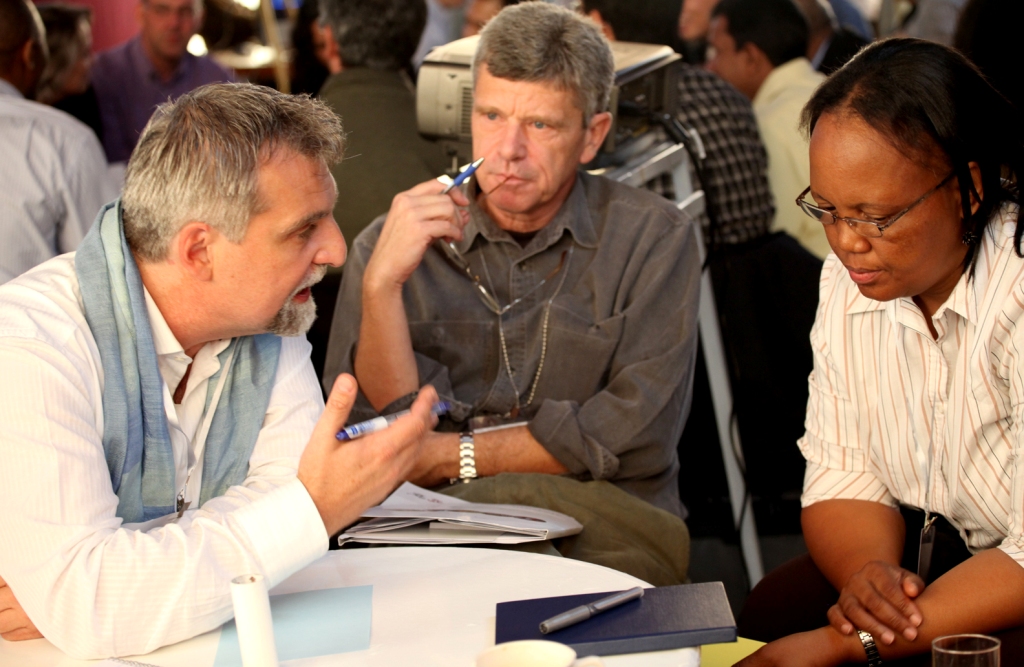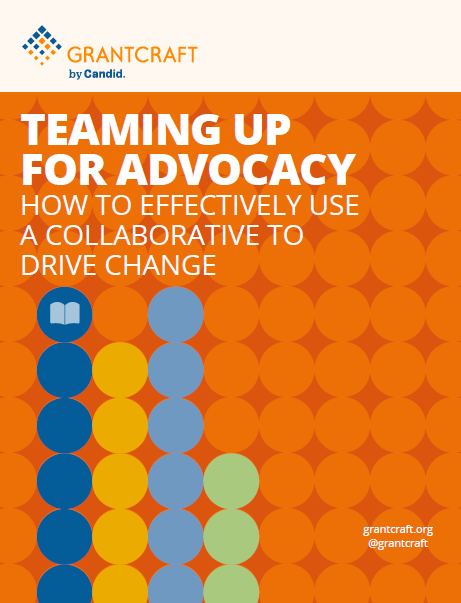What Makes Advocacy Collaboratives Successful?
MOST IMPORTANT: Well-defined goals and agendas
What’s the most important factor in successful advocacy collaboratives? Funders were unanimous: Clear and well-defined goals that all members understand and support and can return to often when there's confusion or conflict. The sharper and narrower the goals are, the better.
How does this help?
- It frames a more strategic discussion among collaborative members for the work. “You have to be focused on a solid target, whether it’s overturning Citizens United or getting comprehensive immigration reform. Even if it’s not successful, having this target forces you into a strategic conversation.”
- It leads the collaborative to be more specific with grantees about what it’s doing, which, in turn, ensures more on-target applicants; rather than having new and broad appeal, the collaborative can more clearly and narrowly articulate a focus.
- It helps mitigate tension when there are disagreements about strategy or direction. “When our collaborative, which had abolishing the death penalty as its major goal, would drift from that or get hung up with disagreements, we’d always bring it back to the goal we all agreed on: abolition. We reminded the group that we were all there to achieve that end goal so we needed to do everything we could do to win.” The goals in this case serve as an accountability mechanism.
- It keeps the work focused on action, rather than “devolving into funder continuing education and things like joint site visits, which are important, but they often aren’t particularly action-oriented. Rolling up your sleeves and digging into specific policy objectives is an experience funders don’t always get to have because their job is usually focused more on doing due diligence.”
- It’s easier to measure progress and success. The fuzzier or more complex the issue is, the harder it will be for funder collaboratives to figure out whether they’ve been successful. “We had very specific policy ends: A Supreme Court decision in our favor and state referendum wins. That’s really different than saying ‘racial justice’ is your goal. You can’t get 100 people in a room to agree on what that is! So, how are you going to figure out if you’ve moved the needle?”
- It creates a clear marker for evolution or disbandment. For some collaboratives, the right thing to do is to “go out of business when they’ve reached their goals, rather than sitting around asking ‘what should we do now?’” Still other collaboratives find that reaching their goal creates a moment to evolve and redefine what the group can achieve together.

In addition to well-defined goals and agendas, there are several other factors that point to success:
- Sticking with it over the long term, with the understanding that success will not necessarily be the result. Policy change is difficult, and it doesn’t happen overnight. Collaboratives can help funders hold steady. “Grantmakers who are part of advocacy collaboratives have to be patient and go into these things understanding that sometimes it takes years to see any kind of change.” And, even after seeing change, policy could be reversed by changes in government or other factors. Because many advocacy collaboratives also provide capacity building support—for both individual grantees and the larger field—sustained commitment is doubly important. “But you have to provide this kind of technical assistance if you want to be successful. You can’t just drop money into groups or locales and hope for the best. It takes time, patience, and focus.”Staying the course, however, can be a heavy lift for a lot of foundations, which tend to “change up their strategy and/or programs every few years.” To deal with this, advocacy funders say that they enlist their collaborative colleagues to pull together a strong case and make commitments to each other that will help persuade their institutions to stay the course. “Our collaborative did this as a group, which each of us could use at our own foundations. We saw that it helped make our institutions feel less anxious about the work because they were able to say, ‘look we have other funders working with us.’”Policy work is risky, and the policy environment is always shifting, meaning that sometimes even the best funder collaboratives may fail in reaching their goals. “Funders who want to join these kinds of collaboratives have to make sure they and their institutions are clear that this work can be very unpredictable and there is always the specter of failure looming over you. You—and your foundation—have to be able to accept that.” While sticking with it is something successful collaboratives do well, funders also caveat that “knowing when it’s time to change approach or even stop working is very tricky. There’s a need to balance staying with the plan long enough to know whether it’s working, but not so long that resources are spent in vain.” Funders focused on the end result need to remain vigilant about monitoring progress, changing contexts, and emerging opportunities to reflect on – and update – strategy to stay on course.
- Getting the right mix of funders to participate. So much depends on having the right mix of people at the table, advocacy funders say. “In our collaborative, we had a nice mix of different kinds of foundations and individual donors. We also had big and small foundations. Having that kind of diversity brought a lot of different and important perspectives to the table.” Small foundations, in particular, “often have a lot to contribute beyond money, so we’re able to take advantage of that by using a more inclusive approach.”Having funders with diverse skill sets at the table is also important. “If we were all experts on these issues in the same ways, we wouldn’t have been as successful.” And, diverse backgrounds across factors such as race, religion, military service, physical ability, sexual orientation, academic training, family structure, and beyond brings essential perspectives that help overcome a single-background narrative. Having members that belong to population groups directly affected by the work of the collaborative is especially essential.And, of course, there’s always the issue of chemistry. “Whether a collaborative works well is about who’s at the table. Do they participate? Do they show up? If the time isn’t well spent or the process isn’t getting you to a good set of decisions you feel good about, it won’t succeed. You’ll also lose participation if you’re unable to find a way to get people to agree and work together well because people won’t feel positive about the experience.” While “chemistry” isn’t a checkbox item that is necessarily seen from the beginning of work together, it is something that is usually known after the first few meetings. Collaboratives with good chemistry understand how to listen to the “gut feeling” of how different people and organizations will gel together, and build the composition of the group accordingly.
- Building and breathing a culture of trust and collaboration. While it might seem logical that funder collaboratives would be, well, collaborative, developing those kinds of cultures can be challenging. “When we started, the field was relatively new, and funders were just getting to know each other as a new group so they had to build trust, which takes time. But we knew that if we were going to get alignment around a shared strategy, we were going to have to trust each other first. As a long-time advocacy funder and activist, I’ve seen that no matter what the issue, the more funders know and trust each other, the more successful they are.”Grantmakers say it’s important that the collaborative’s members—especially long-time members—and staff be intentional about promoting an inclusive and informational culture that adds value to people’s work. “Like any good organization, you have to make it a political home that people like. You can’t do it on dry merit alone. People have to feel affirmed.”Making new donors feel comfortable is also important. Some collaboratives have existing members invite new members out for drinks or coffee to answer questions they might have before a larger meeting. Others have a culture that encourages new members to “say anything at the table, and you’re not considered a ‘junior’ member. It’s good for new members to see that and be embraced by everyone. This kind of openness and acceptance makes it easier to recruit new people to our advocacy collaborative.”
- Including the field affected by the collaborative’s work in shaping the strategy for the collaborative. Many grantmakers believe that advocacy collaboratives work best when their strategies reflect the involvement of the issue-specific field and its stakeholders —from helping to set priorities to designing the strategy. “If you’re in our collaborative, you have to agree to work with and take direction from the strategic leadership of the campaign we’re supporting and who aren’t grantmakers. They are the strategists, and if they say, ‘the next six months, we really need communications’ or ‘next year, we’re getting bills in Utah and South Carolina so let’s work there,’ we’ll listen to what they say and align our funding accordingly.”Some funders, however, believe that grantmakers and the field can have parallel strategies as long as they’re mutually complementary “and there’s communication between the two.” What’s most important, they say, is being clear about grantmakers’ role in the process—not just to the collaborative’s members but also to strategists leading the campaigns. “You have to have a sense of who you are in the field. Are you another advocate? Or are you a partner with the grantees in the field? Are you a collaborator? Or are you taking a more traditional approach—being more at arm’s length from the grantees and being in control of making the decisions? It’s important to be clear and transparent about this with grantees.”
- Leaving egos at the door. Advocacy funder collaboratives, funders agree, aren’t the place for big egos. To be successful in a collaborative, “individual members need to be committed to contribution not attribution! They need to check their institutional egos at the door. The focus needs to be on what the group is doing and who they’re doing it for—not on who gets credit.”Compromise and humility play an important role. “You’re joining with others, and you broaden your focus when you sit down at the table. You decide you’ll be more effective in a collaborative than you would be on your own because there’s strength in numbers.”
- Hiring quality staff or facilitators. A number of advocacy funders point to staffing as a key ingredient in successful collaboratives. “We’ve been able to pay for the staffing at our collaborative. Two of those staff members came from foundations that had donated to the collaborative. Other funders have thought about applying for these jobs, which says something about the quality of the staffing. If you can afford it, hiring smart staffers is a smart move the collaborative should support.”Sometimes that staffing comes in the form of an intermediary. “I’ve found that collaboratives that have used intermediaries well tend to be quite effective. They have to be supported, though, because they provide a lot of additional services for grantees like capacity building, technical assistance, and convenings—a lot of the stuff that individual funders can’t or don’t do but that are critical to sustaining this work!”Having a “strong facilitator who’s not a grantmaker”—either as part of the staff or as a consultant—is also important, many grantmakers say. “There are many occasions collaboratives may need to call in an external facilitator—disagreements about strategy, personality conflicts, analysis paralysis, and other issues that the group may be unable to resolve itself. We’ve found them to be enormously helpful in getting us unstuck.”
- Promoting strong leadership. Some grantmakers say that the best advocacy collaboratives “are those with someone—or a group of funders—with a clear vision and who can bring people along with that vision.” An important part of that leadership is being ever vigilant to potential problems or challenges that could derail the group’s commitment or solidarity to the goals they agreed on.That doesn’t necessarily mean that collaboratives have to have a formally-elected or appointed leader. Rather, all members should feel comfortable in assuming the role of helping the group keep on track when it starts to veer off.That sometimes requires different skill sets. After serving as the leader of an advocacy funder collaborative, one grantmaker said that she’d come to realize that leadership isn’t just about vision or “keeping the eyes on the prize.” While those are important, if she ever led a collaborative again, she’d approach that role differently—“less as a director and more a facilitated leadership approach. I’ve learned how important good facilitation can be when it comes to keeping collaboratives running smoothly because so much is about facilitating decisions, not forcing them.”
- Building a strong field and infrastructure to support ongoing policy work on the issue(s). A striking number of funder advocacy collaboratives view field building as important as “wins.” “You can have a bunch of policy wins, but if there’s no infrastructure to support the work going forward, it won’t have as much impact.”There are many ways to do this—capacity-building assistance, organizational development support, general support. The important thing to remember, however, is that while “policy goals are the priority, advocacy collaboratives also have to keep their eyes on the infrastructure behind pushing for those policies.” Without it, another funders says, “this work will never be sustainable.”
- Funders see value in their participation. Successful advocacy collaboratives have robust participation. “Grantmakers have to perceive that they’re getting a lot of value from their involvement. Otherwise, they’ll leave because they want their time to be well spent.” Maintaining participation and longevity, in fact, can be a good barometer of what’s working for the people participating in the collaborative. “If they don’t show up or don’t participate or leave halfway through—those are warning signs.”Unsurprisingly, the more people know and trust the other collaborative members, the more incentive there is to participate. “Four or five times a year, we’d meet as a group and just be in a room where we spent full days together. We got to know each other well and build trust, because we not only talked about issues but had meals together. You can’t underestimate the value of that.” The opposite is also true: “A collaborative I was part of only met once a quarter for two hours. People didn’t see the value of participation vs. value of ‘just funding the effort’ because funders didn’t really get to know each other. For these things to work really well, you need a lot of funder engagement.”
NOW REFLECT:
- What do you see as the most important factors in predicting success?
- How many of these elements do you see reflected in your collaborative?
- Are there other factors not mentioned here that you think are important contributors to a collaborative’s success? What makes them important?
FURTHER READING:
- Strengthening Collaborations to Build Social Movements: Ten Lessons from the Communities for Public Education Reform Fund (CPER)
- How Funder Collaborations Flourish: Lessons from the Common Core Standards
Please click here for information on GrantCraft’s methodology for this research.
(Photo: Apollo Habtamu, licensed under CC BY-NC-SA 2.0)


